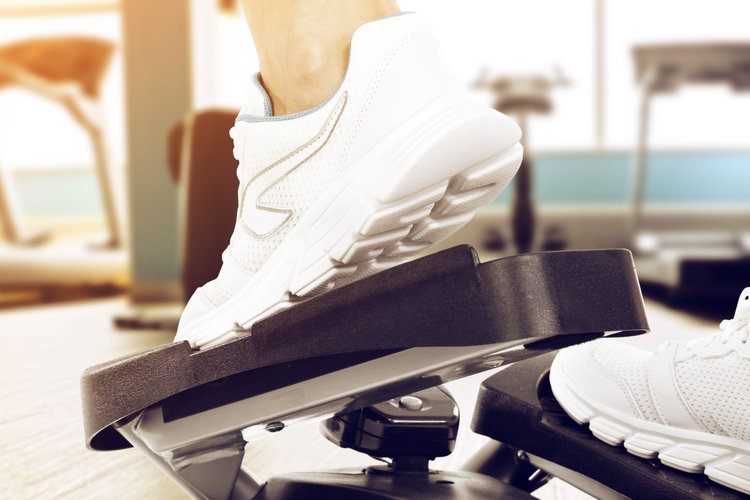Training on an elliptical machine is one of the types of aerobic activity that directly affects the bulk of the muscles of the upper and lower parts of the body. The unique design of the elliptical machine makes them an accessible tool for maintaining shape, developing endurance, and strengthening the heart muscle for a wide category of athletes. Let’s learn how to properly engage on an elliptical machine.
Exercise technique
Initial position:
- If possible, adjust the step length depending on the height (see below for how to choose the step length)
- Holding the stationary handrail, stand on the pedal of the simulator.
- Give the body a vertical position and level the back.
- Move your hands on the moving arms of the machine. This will be your starting position.
- Foot tightly put on the pedal simulator.
Motion:
- Start the movement: push the leading foot forward, simultaneously attracting the handrail with the opposite hand.
- Immediately after this, without stopping, perform a similar movement from the second leg, using the opposite hand.
- In the final part of the training session, slow down the pace of movement, moving to walk.
- Finish the lesson on an elliptical machine and, keeping to a fixed handrail, get off the trainer steps.

Attention!
- Do not move the weight from one foot to the other. Movement should be synchronous and smooth, and the center of gravity falls approximately in the center of the body.
- Do not use clothing with a “thermal effect”. The delay in the discharge of moisture creates an excessive load on the cardiac system.
- Do not start the movement without taking a stable starting position with both feet on the simulator pedals.
- Do not relax your feet when practicing on an ellipsoid: while one leg is moving, the other should be in good shape.
- Do not lean on handrails. This reduces the load on the trained muscles of the lower body.
- Do not hold your breath while performing exercises on the ellipsoid. Perform uniform inhalations and exhalations during the whole session.
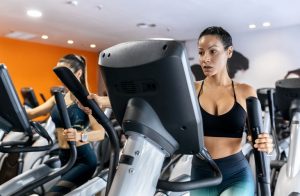
Recommendations!
- Walking on the simulator, make sure that the step on which you are going to the first step, is in the lower position.
- The first time doing exercises on an ellipsoid, always stick to the handrails. The lack of contact with the handrails of an unprepared athlete increases the risk of loss of balance and falling.
- Use shoes that provide good coupling with the pedals of the simulator and provide a fairly stable position.
- Perform a continuous movement with both feet, not keeping pauses.
- Start the movement with a slow walk, gradually increasing the pace of movement. This allows the body to get used to the specifics of movement and reduces the likelihood of injury.
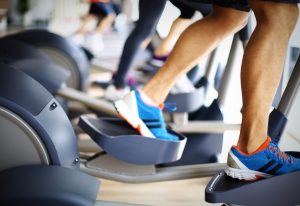
Variants of exercise on the elliptical machine
- Walking with the body tilted forward. This variant of the exercise involves tilting the upper part of the body forward, towards the console of the simulator approximately 45 ° from the initial vertical position. This reduces the degree of participation in the movement of the shoulder girdle and the muscles of the cortex and increases the impact on the quadriceps and calf muscles.
- Reverse walking. It differs from the main variant in the direction of movement, due to which the vector of action of the load moves to the area of the buttocks and lower back. Please note: with “reverse flow” walking, the knee bends more strongly, which increases the load on the joint.
- Walking with the body tilted back. Leaning back, the athlete automatically takes a position close to the squat. In this position, the thighs and gluteal muscles take on the greatest load; the core is actively involved. When performing this exercise, it is most convenient to hold onto a fixed stationary handrail.
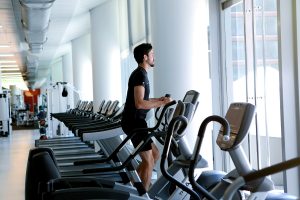
Exercise analysis
Anatomy of an exercise: which muscles work?
The elliptical machine is a representative of the group of cardio-simulators, the main feature of which consists in the specific ellipsoidal trajectory of the pedal movement. This constructive zest defines a wide range of existing variations of the “core” exercise, which allows for a complex effect on a large muscle mass:
- The muscles of the legs (quadriceps, the back of the thigh, the muscles of the lower leg);
- Gluteal muscles (in particular the large gluteal);
- The musculature of the cortex (back and abdominals);
- Thoracic musculature;
- The muscles of the shoulder girdle and arms (biceps and triceps).
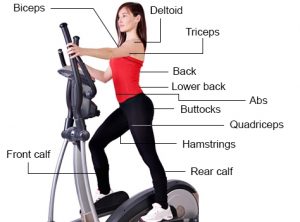
Advantages and disadvantages of elliptical machine
Ellipses have incorporated several cardiovascular machines at once, so the benefits of using them are quite large:
- The development of the cardiovascular and respiratory systems;
- Complex load on the muscles of the upper and lower parts of the body;
- Reduced injury, lack of “stress” for the joints and spine in comparison with other simulators of this type;
- High versatility (suitable for athletes of all ages and fitness levels);
- Wide functionality that makes it possible to implement with the help of many training goals.
Among the shortcomings of ellipses, one can only note that it is a little more difficult to adapt to the peculiarities of walking on them than to the movements on a treadmill or exercise bike.
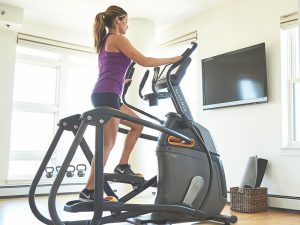
Preparing for the workout
Spend a light general warm-up before aerobic exercise, paying attention to the muscles and joints that will be involved in the operation of the simulator:
- warm-up the knee and hip joints, develop the ankle, making rotational movements of them;
- perform a series of squats, body inclinations, lunges, swing movements.
- additionally include in the preparatory part of the workout stretching muscles.
- Choose a simulator according to the step length that suits your height, if it is possible to adjust, then follow the data in the table:
| User height (cm) | Min step length (cm) | Recommended step length (cm) |
| 155 | 30 | от 30 |
| 155-160 | 33 | от 35 |
| 160-165 | 34 | от 37 |
| 165-170 | 35 | от 40 |
| 170-175 | 37 | от 43 |
| 175-180 | 38 | от 45 |
| 180-185 | 40 | от 47 |
| 185-190 | 45 | от 50 |
| 190-195 | 47 | от 50 |
| от 195 | 50 | от 53 |
Correct execution
- When leaving the simulator or standing on it, you should always stick to the fixed rail.
- In the basic version of the position on the simulator, the body of the athlete must be in an upright position – thus it is possible to use all the major muscle groups. Training accents can be moved by changing the position of the body relative to the simulator or the direction of movement.
- The head of the athlete is in line with the spine to avoid tension in the muscles of the cervical region and maintain the correct posture.
- The standard is the position of the feet on the simulator, in which they are parallel to each other and centered relative to the edge of the pedals.
The movement begins with pressure on the heel.
Performance recommendations
- When practicing on an ellipsoid, the “continuity” of the load is extremely important. Even those who find it difficult to perform the planned amount of training work in a stable intensity mode should not be abruptly interrupted (this negatively affects the functionality of the heart) – it is necessary to decrease to minimum intensity, and then, focusing on your well-being, either to recover to the previous rhythm of work or complete workout.
- Performing exercises on an empty stomach can cause dizziness. It is optimal when the time interval between the start of an aerobic session on an ellipsoid and the last meal is at least 90 minutes.
- To focus the load on the lower body, use a stationary handle. The use of movable handles is advisable during the execution of programs for weight loss because in general, it allows increasing the intensity of the load.
Mistakes
- Improper distribution of body weight.
- Lack of control over posture.
- Pressure on the toe when performing a step on an ellipse.
- Lack of progress in loads.
- Neglect workout.
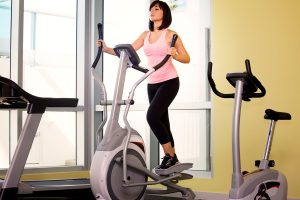
Inclusion in the program
Exercises on an ellipsoid can be used as a warm-up stage before power or aerobic exercise. In this case, it is enough to warm up for 10 minutes in the low-intensity mode (50% of the maximum heart rate) and proceed to the implementation of the main complex of movements.
However, most often the simulator is exploited for a specific purpose: to adjust body weight, to bring muscles into tone, to develop indicators of endurance. As part of these tasks, the number of workouts on an ellipsoid in a weekly microcycle should be from 3 to 6 (the final frequency is determined based on the level of fitness of the athlete and the features of the program).
Important: with all the multifunctionality of the ellipse, you should not expect that with its help you can significantly increase muscle mass – for this, strength training should be included in the training program.
Elliptical Workout Programs
Slimming training
The optimal method for the correction of body weight is training on an elliptical machine in the pulse corridor 60-80% of the maximum. In this case, the effective session duration is 20-50 minutes. Naturally, beginners are advised to stick to the lower limit of the duration and heart rate indicators.
How many calories are burned on an elliptical machine? The number of calories “destroyed” in the process of training is the most burning question for a slimming person. It is quite easy to track this figure: usually, the simulators are equipped with a calorie consumption counting sensor. But if you don’t have one on your ellipsoid model, calculate it yourself, guided by the average waste rates: ≈ 9.6 kcal per hour per 1 kg of its own weight. Naturally, this figure may vary depending on the intensity of the load, as well as external factors (such as air temperature in the room, etc.), but a rough idea of the “effectiveness” of the training will be obtained.
Training to strengthen the muscles and increase stamina
Physically trained athletes can recommend the practice of interval training on an elliptical machine, which involves a periodic change in the magnitude of the loads: alternating short durations (up to 1 minute) of high-intensity intervals and longer (2-3 minutes) low-intensity intervals. Such a training scheme gives a good return both in improving the tone (and even a small amount) of muscles and in the development of aerobic endurance.
The total duration of training according to the proposed method ranges from 15 to 25 minutes, and the recommended heart rate is controlled at 75% -90% of the individual maximum.
To further develop the power potential of the muscles, as well as increase the intensity of the work, it is necessary to perform exercises on an elliptical machine with increased resistance.
Important: whatever goal you pursue, and whatever program is exploited, do not forget about the need to periodically change the magnitude of the load. Compliance with this condition will be the guarantor of your long-term training progress.
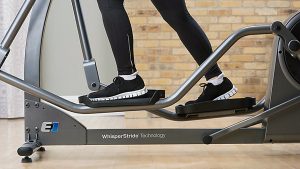
Pulse control
Modern models of elliptical machines are equipped with heart rate monitors (usually located on the arms, have the form of ear clips or chest sensors), which allow you to monitor the athlete’s well-being and with sufficient accuracy and change the training load.
The guideline for individual adjustment should be the maximum pulse value, calculated by subtracting from 220 the value of your own age (in years). Check the data with the sensor readings and adjust the intensity for your goals.
Contraindications
The mechanics of movements on an elliptical simulator eliminates the likelihood of damage to the ankle apparatus, as well as the shock load on the spine and joints (due to the stationarity of the feet and the specific trajectory of motion). For this reason, “ellipsoids” are the only and safest cardiovascular option for injuries of the areas listed, as well as for overweight athletes.
However, like any other aerobic activity, training on the simulator is quite demanding on the health of the cardiorespiratory system involved. In particular, athletes suffering from heart disease (hypertension, tachycardia, rest/exertion angina, heart failure) are encouraged to discuss the possibility of training on an elliptical machine with their doctor.
It is also recommended to abandon classes on the elliptical machine for the period of rehabilitation after respiratory diseases.

